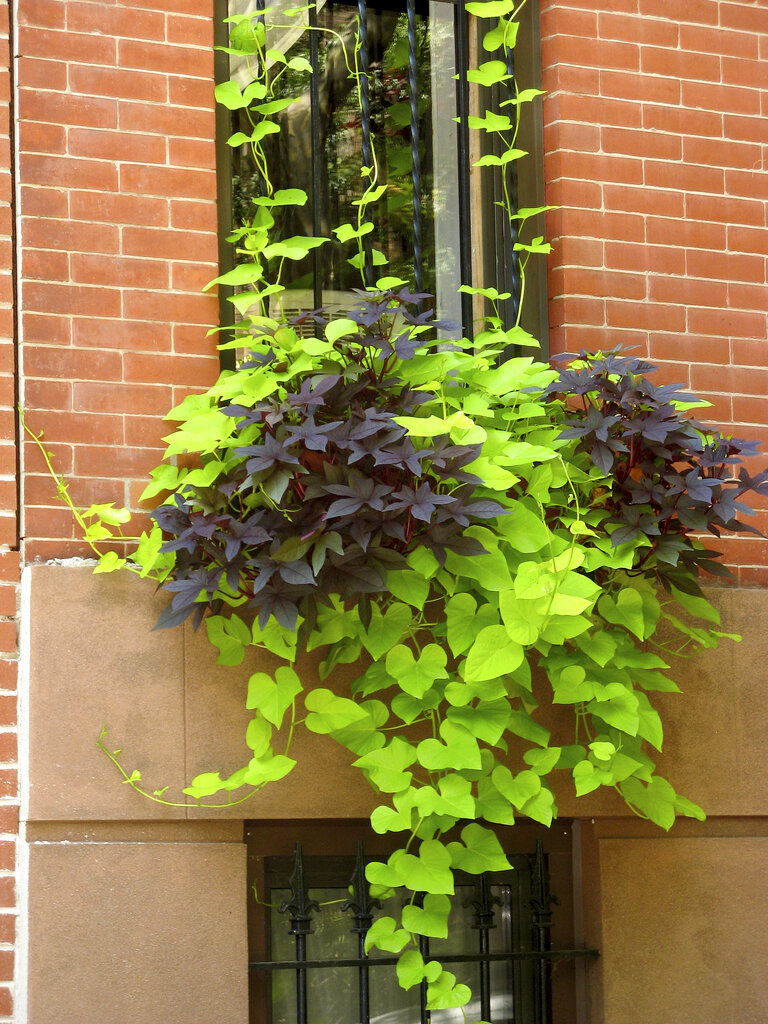
The gardening world has a tried-and-true formula for the perfect window box: a thriller, a filler and a spiller. You simply can’t go wrong with a tall red geranium amid a tranquil bed of white impatiens and cascading vines of ivy.
But maybe you’re an experienced window box gardener looking to try something different. Or maybe you’re sticking close to home this spring and summer and you need a new pandemic project. How about a window box filled with succulents like aloes and echeverias, or edibles like herbs and nasturtiums, or even carnivorous varieties like Venus fly traps and pitcher plants?
Whether you’re a newbie or an old hand, here are some expert tips on window-box basics, as well as ideas for unusual themes.
LOCATION AND SAFETY
Window boxes aren’t just for window sills. They can sit on porches, patios, or front steps, or even add color to the side of a drab shed.
For apartment-dwellers, window boxes are a wonderful way to garden without outdoor space. “But safety first: People do get killed by falling window boxes,” says Nina Browne, community program manager at New York’s Brooklyn Botanic Garden.
Just as you would with an air conditioner, make sure your window boxes are secured so they can’t fall or blow down in a storm. Because of these potential hazards, window boxes are sometimes prohibited by landlords, building associations and property insurers. An indoor window box makes a fine alternative.
LIGHT AND WATER
Before choosing plants, evaluate your window box location for light and moisture. Window boxes dry out faster than in-ground plants, so they need a lot of watering, especially if south-facing. But a window box flush against an exterior wall may be more sheltered from rain than a flowerbed in your yard.
Browne says one of her greatest triumphs as a gardener is a beautiful window box in a north-facing, full-shade spot. She gets a lush, full look using coleus, caladium and oxalis, which all have foliage in burgundies and greens with interesting patterns and shapes. Sweet potato vines serve as spillers.
How about succulents? They do best in south- or west-facing windows, according to Matthew Pottage, curator of the Royal Horticultural Society Garden Wisley in Surrey, England. His window box full of drought-tolerant plants has “survived the wet and cold of London for some seven years.”
THE CLASSIC APPROACH
Steph Green, owner of Contained Creations in Richmond, Virginia, is an advocate of the classic thriller-filler-spiller approach. “I love the layers of color and texture,” she says.
Noting that window boxes are usually seen only from the front and sides, Green centers her tallest plant flush against the back of the box, then adds fillers to the left, right and front. Spillers are tucked along the perimeter, leaving room to “grow and cascade over the edges.”
For a sunny spot, Green’s favorite thrillers are Kimberly queen fern, dwarf Alberta spruce, and sago palm; for fillers, boxwood, dusty miller, pentas, sunPatiens and dipladenia; and for spillers, sweet potato vine, mezoo, dichondra silver falls, dwarf morning glory, fan flower and petunias.
For shade, she likes the Kimberly queen fern and Dracaena lemon lime as thrillers; boxwood, coral bells, fancy leaf caladium and impatiens as fillers; and creeping Jenny, dead nettle, English ivy and variegated Swedish ivy for spillers.
NOT YOUR GRANDPARENTS’ WINDOW BOX
You’ll find 16 different window-box concepts in “How to Window Box,” by Chantal Aida Gordon and Ryan Benoit, who also run The Horticult website. Their woodlands theme box uses bleeding heart, hosta and columbine; an indoor “jungle box” includes monstera and elephant’s ear; and a “Southern belle” box mixes foxglove, snapdragon, sweet potato vines and dusty miller.
A “tiny island” design is “full of bromeliads, really colorful, like a little trip to Hawaii,” Gordon said. “We even built a tiny trellis for air plants. It’s definitely not your grandparents’ window box.”
THE “WOW” FACTOR
What gives some window boxes their “wow” factor while others are just so-so? Maintenance is part of the difference, says Benoit. “People who have really nice window boxes are cutting off dead, spent leaves and blooms,” Benoit said. They’re also watering a lot and “changing things up a lot. Some plants are only going to look good for one season.”
That means replacing spring tulips and hyacinths with petunias and zinnias in summer, followed by mums and flowering kale come fall. And don’t let quick-growing plants like coleus and impatiens get too leggy.
To remedy window-box blahs, Benoit offers this hack: Take a bright cut flower from your backyard or a florist’s bouquet, insert the stem in a slender tube filled with water, and tuck it in amid your window box plants.
HEY NEIGHBOR, I LIKE YOUR WINDOW BOX
The Brooklyn Botanic Garden runs an annual “Greenest Block in Brooklyn” contest. This year, BBG is promoting window boxes as a way for neighbors to “garden together” while remaining socially distant.
“We are not looking for professional gardening,” says Browne. “We’re looking for creativity, love, neighborliness. One person tries something, and suddenly their neighbor is saying, ‘That’s really nice, how did you do that?'”
"traditional" - Google News
April 20, 2021 at 09:54PM
https://ift.tt/3an9tMQ
Going beyond the traditional window-box garden - Sentinel Colorado
"traditional" - Google News
https://ift.tt/36u1SIt
Shoes Man Tutorial
Pos News Update
Meme Update
Korean Entertainment News
Japan News Update
Bagikan Berita Ini














0 Response to "Going beyond the traditional window-box garden - Sentinel Colorado"
Post a Comment